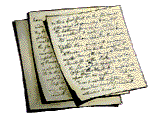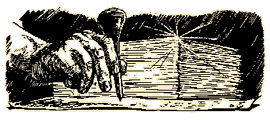
|
THE SPALDING
RESEARCH PROJECT |

|
Dale R. Broadhurst's "Spalding Papers"
"Index" -- 01 02 03 04 08 09 10 11 12 13 14 15 16 -- "Home"
Paper 12 - Part IIIg
Commentary on M. D. Bown's
Book of Mormon / Spalding MS Parallels
( Bown's Notes )

Revision 0a: September, 1998
Editorial and Bibliographic Information
Go Back to Intoduction & Index [ pp. 01 to 06 ]
|
The following notes were footnotes in Bown's original paper. I have combined them here and renumbered them as endnotes. The note numbers are linked back to their respective positions in Bown's text. NOTES 1 Since this Bible version was not completed until 1611 and reflects the scholarship and English of the day, it has been the basis of many objections to the authenticity of Smith's work. But cf. Roberts, op. cit., 425-440, for a defense. 2 At least two contemporary works use the same device: Thomas Moore's THE EPICUREAN, 1827, was supposed to have been translated from a Greek manuscript found in Egypt; W.B. Hockley's PANDURANG HARI, 1826, purposed to be a translation from a native Hindi MS. U.S, circulation not determined. Cf. E.A. Baker: A GUIDE TO HISTORICAL FICTION, London: Routledge, 1914. 3 Joseph Smith: HISTORY OF THE CHURCH OF JESUS CHRIST OF LATTER DAY SAINTS. Salt lake City, Deseret News, 1908, IV, p. 537. 4 Joseph Smith, op. cit. Vol. I, p. 15. 5 Ibid. p. 16. 6 Joseph Smith, op. cit. Vol. IV, p. 537. 7 The voyage of the Jaredites is not included here, due to the limited number of parallels with the Spaulding account that appear, nor in the eight items following. 8 Called a "Revelation to Joseph the Seer" in Richards and Little" A COMPENDIUM OF THE DOCTRINES OF THE GOSPEL." Salt Lake City: Deseret News, 1884, p. 289. B.H. Roberts is not certain that the observation was really a revelation (Cf. Roberts, op. cit. pp. 501-504.) Orson Pratt believed that the party landed near the 30th degree south latitude. (Sjodahl, op. cit.[?] p. 92). Elsewhere, Joseph Smith clearly locates the story on the American continent. (Smith, op. cit. pp. 537-538) 9 Nothing that might be termed a "cement house" has ever been found on this continent by archaeologists. The term "cement" does not occur in the Bible anywhere. 10 Such material would be perishable, which may account for the complete lack of wood remains among early American archaeology. The Peruvians understood the art of working timber only slightly, judging from the evidence, and this may also be said of the other peoples, due probably to their paucity of tools. (Cf. the discussion in S.W. Traum: MORMONISM AGAINST ITSELF. Cincinnati: Standard, 1910, 139-144. An anti-Mormon, but he is quoting archaeologists.) 11 Mentioned because while a type of corn is and was familiar to the native Americans, wheat appears to have been entirely unknown, and it seems strange that the use of so valuable a grain should have died out. Wheat is commonly said to have been first introduced on this continent by the Spaniards into Mexico as early as 1530, and by the Virginia and Massachusetts settlers in 1607. (Cf. ENCYCLOPEDIA BRITANNICA) 12 the BOOK OF MORMON instruments are mentioned in the Bible, in the same words: ". . . the harp and the viol, the tabret and pipe. . ." occurs in Isaiah 5:12; ". . . the noise of thy viols" in Isaiah 14:11 (Cf. also Amos 5:23, 6:5). The tabret was a sort of drum or tambourine; "viol" is the Hebrew "nebel," a type of lyre. True viols were unknown until the 15th century. Cf. Hastings DICTIONARY OF THE BIBLE and the ENCYCLOPEDIA BRITANNICA under appropriate articles. 13 Perhaps the BOOK OF MORMON does not refer to personal or physical filthiness, but instead may be concerned in these quotations with "moral filthiness." The expressions "whitened garments" and "washed in the blood of the Lamb" are common enough elsewhere in religious discourses and are usually taken in the moral sense. 14 Arbaugh cites a report of the Bureau of American Ethnology that only "worship of mythic animals and nature-gods" was known to the pre-Columbian inhabitants. Cf. Arbaugh, op. cit, p. 17. The "Great Spirit" of the modern Indian is the best English equivalent of their term, but is hardly ancient. 15 Coriantumr was subsequently found by the Mulekites, a people who appear to have preceded the Nephites in arriving on this continent. He dwelt among them "nine moons" and is not mentioned further. Cf. Omni 1:15 and 21. 16 Accidentally omitted previously. Should follow item #47 or thereabouts. |
Commentary on M.D. Bown: [Index] [parallels 01-14] [parallels 15-24] [parallels 25-47]
[parallels 48-59] [parallels 60-78] [parallels 79-99] <-> [Names Index] [Editorial & Bibliographic Info.]
Spalding Studies Home Page: [Introduction] [SRP] [Broadhurst Papers] [E-mail Site Host]
revision 0a: September, 1998